Risk Management Report: Analysis of Loss Prevention Strategies
VerifiedAdded on 2020/03/07
|10
|2792
|56
Report
AI Summary
This report delves into the multifaceted realm of risk management, encompassing a detailed exploration of loss prevention strategies, and the application of the 'as low as reasonably practicable' (ALARP) principle. It examines various risk management tools, particularly the event chain methodology, and its significance in project management. The report further analyzes the sources of failure within business entities, categorizing them as managerial, hardware, software, and human errors. A case study of BP Global is included, evaluating its safety policies, procedures, and risk management systems. The report concludes with an overview of loss prevention arrangements, including the tracking of safety performance and the measurement of past incidents, to identify areas for improvement and ensure a safe operational environment.
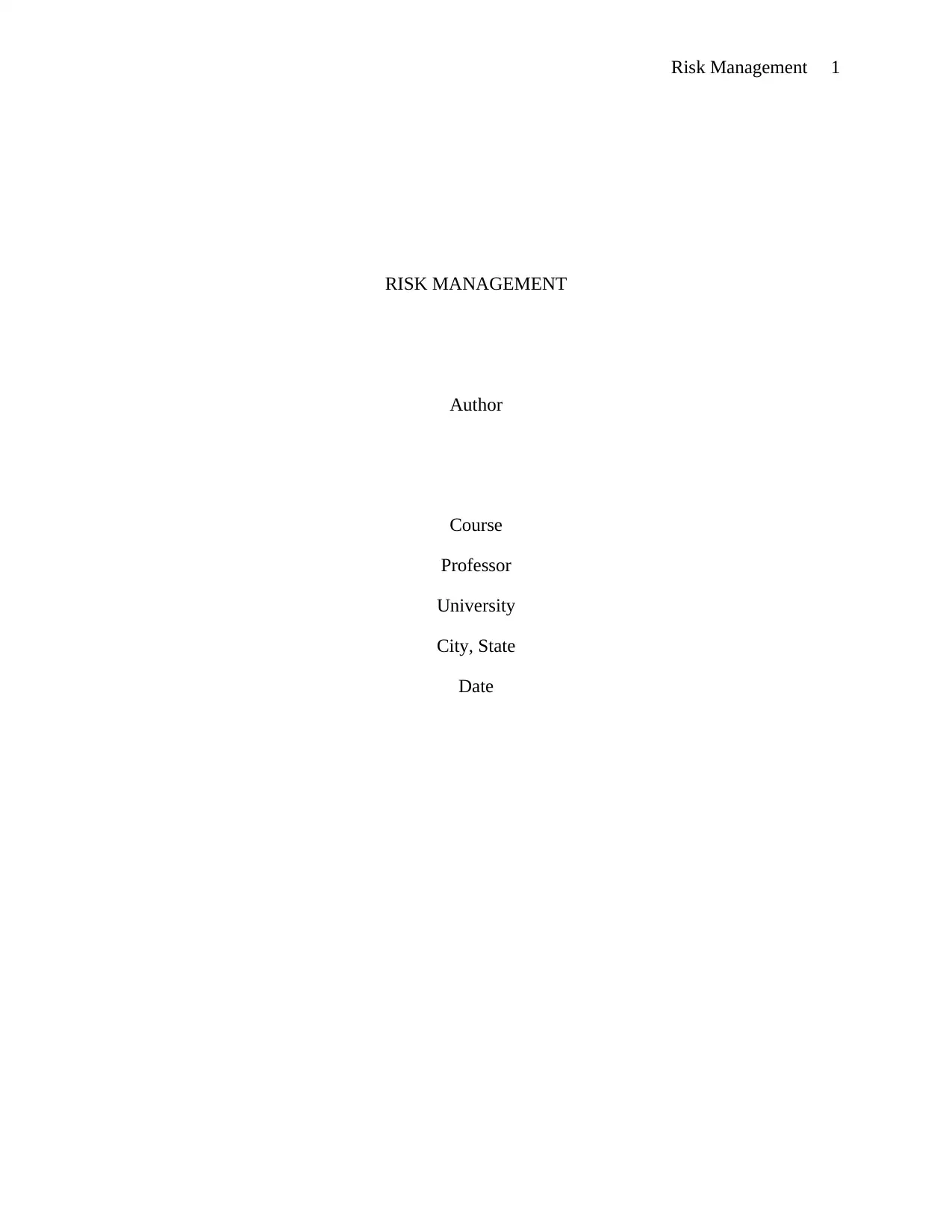
Risk Management 1
RISK MANAGEMENT
Author
Course
Professor
University
City, State
Date
RISK MANAGEMENT
Author
Course
Professor
University
City, State
Date
Paraphrase This Document
Need a fresh take? Get an instant paraphrase of this document with our AI Paraphraser
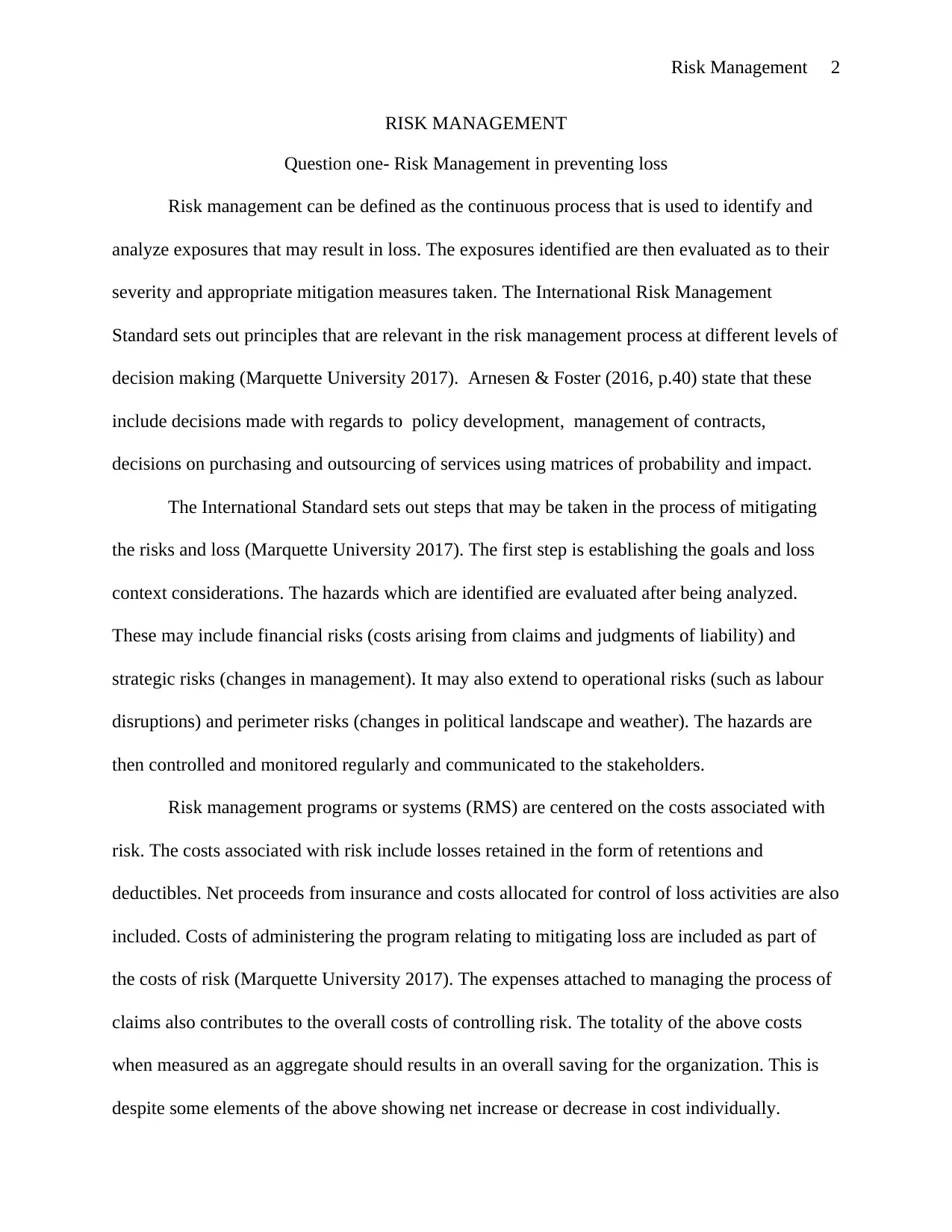
Risk Management 2
RISK MANAGEMENT
Question one- Risk Management in preventing loss
Risk management can be defined as the continuous process that is used to identify and
analyze exposures that may result in loss. The exposures identified are then evaluated as to their
severity and appropriate mitigation measures taken. The International Risk Management
Standard sets out principles that are relevant in the risk management process at different levels of
decision making (Marquette University 2017). Arnesen & Foster (2016, p.40) state that these
include decisions made with regards to policy development, management of contracts,
decisions on purchasing and outsourcing of services using matrices of probability and impact.
The International Standard sets out steps that may be taken in the process of mitigating
the risks and loss (Marquette University 2017). The first step is establishing the goals and loss
context considerations. The hazards which are identified are evaluated after being analyzed.
These may include financial risks (costs arising from claims and judgments of liability) and
strategic risks (changes in management). It may also extend to operational risks (such as labour
disruptions) and perimeter risks (changes in political landscape and weather). The hazards are
then controlled and monitored regularly and communicated to the stakeholders.
Risk management programs or systems (RMS) are centered on the costs associated with
risk. The costs associated with risk include losses retained in the form of retentions and
deductibles. Net proceeds from insurance and costs allocated for control of loss activities are also
included. Costs of administering the program relating to mitigating loss are included as part of
the costs of risk (Marquette University 2017). The expenses attached to managing the process of
claims also contributes to the overall costs of controlling risk. The totality of the above costs
when measured as an aggregate should results in an overall saving for the organization. This is
despite some elements of the above showing net increase or decrease in cost individually.
RISK MANAGEMENT
Question one- Risk Management in preventing loss
Risk management can be defined as the continuous process that is used to identify and
analyze exposures that may result in loss. The exposures identified are then evaluated as to their
severity and appropriate mitigation measures taken. The International Risk Management
Standard sets out principles that are relevant in the risk management process at different levels of
decision making (Marquette University 2017). Arnesen & Foster (2016, p.40) state that these
include decisions made with regards to policy development, management of contracts,
decisions on purchasing and outsourcing of services using matrices of probability and impact.
The International Standard sets out steps that may be taken in the process of mitigating
the risks and loss (Marquette University 2017). The first step is establishing the goals and loss
context considerations. The hazards which are identified are evaluated after being analyzed.
These may include financial risks (costs arising from claims and judgments of liability) and
strategic risks (changes in management). It may also extend to operational risks (such as labour
disruptions) and perimeter risks (changes in political landscape and weather). The hazards are
then controlled and monitored regularly and communicated to the stakeholders.
Risk management programs or systems (RMS) are centered on the costs associated with
risk. The costs associated with risk include losses retained in the form of retentions and
deductibles. Net proceeds from insurance and costs allocated for control of loss activities are also
included. Costs of administering the program relating to mitigating loss are included as part of
the costs of risk (Marquette University 2017). The expenses attached to managing the process of
claims also contributes to the overall costs of controlling risk. The totality of the above costs
when measured as an aggregate should results in an overall saving for the organization. This is
despite some elements of the above showing net increase or decrease in cost individually.
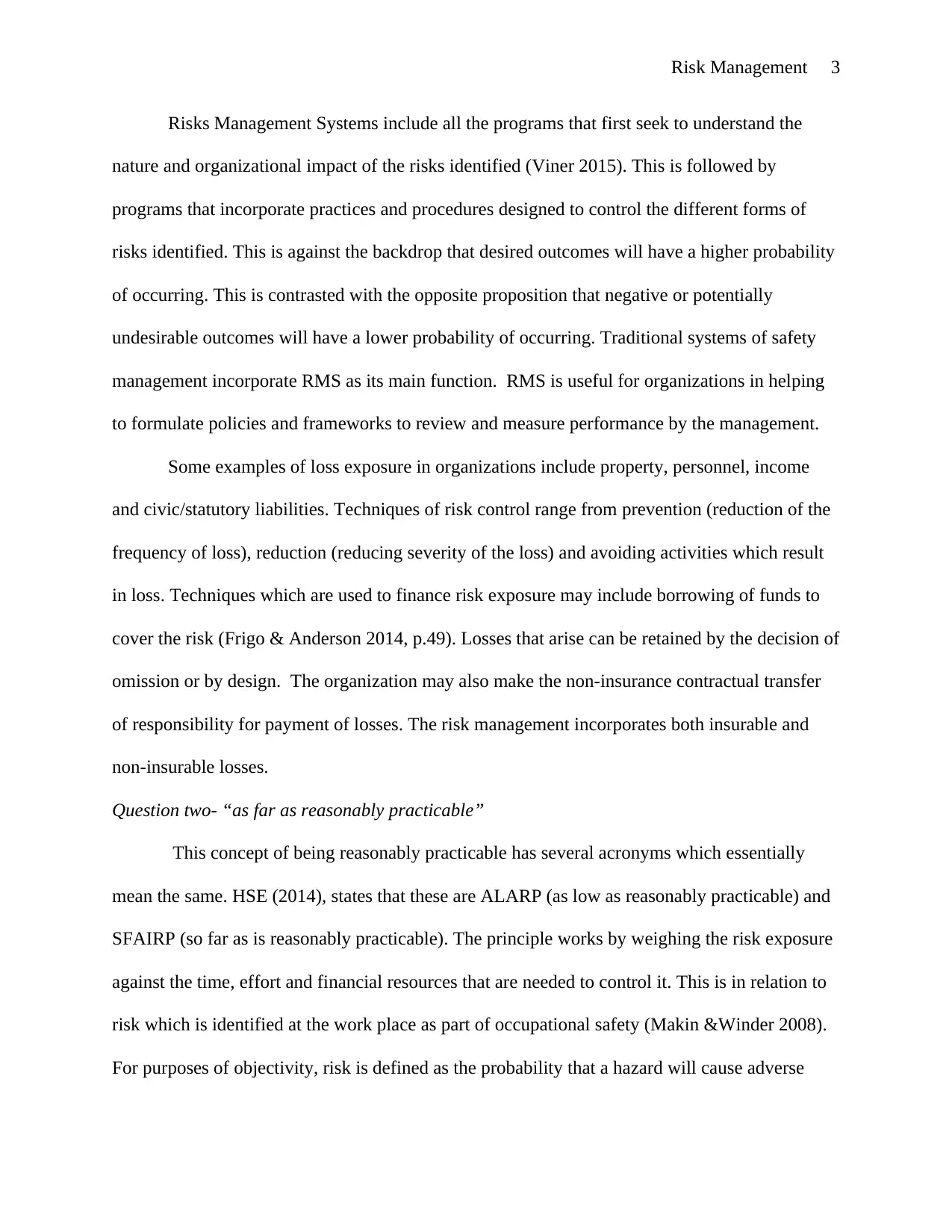
Risk Management 3
Risks Management Systems include all the programs that first seek to understand the
nature and organizational impact of the risks identified (Viner 2015). This is followed by
programs that incorporate practices and procedures designed to control the different forms of
risks identified. This is against the backdrop that desired outcomes will have a higher probability
of occurring. This is contrasted with the opposite proposition that negative or potentially
undesirable outcomes will have a lower probability of occurring. Traditional systems of safety
management incorporate RMS as its main function. RMS is useful for organizations in helping
to formulate policies and frameworks to review and measure performance by the management.
Some examples of loss exposure in organizations include property, personnel, income
and civic/statutory liabilities. Techniques of risk control range from prevention (reduction of the
frequency of loss), reduction (reducing severity of the loss) and avoiding activities which result
in loss. Techniques which are used to finance risk exposure may include borrowing of funds to
cover the risk (Frigo & Anderson 2014, p.49). Losses that arise can be retained by the decision of
omission or by design. The organization may also make the non-insurance contractual transfer
of responsibility for payment of losses. The risk management incorporates both insurable and
non-insurable losses.
Question two- “as far as reasonably practicable”
This concept of being reasonably practicable has several acronyms which essentially
mean the same. HSE (2014), states that these are ALARP (as low as reasonably practicable) and
SFAIRP (so far as is reasonably practicable). The principle works by weighing the risk exposure
against the time, effort and financial resources that are needed to control it. This is in relation to
risk which is identified at the work place as part of occupational safety (Makin &Winder 2008).
For purposes of objectivity, risk is defined as the probability that a hazard will cause adverse
Risks Management Systems include all the programs that first seek to understand the
nature and organizational impact of the risks identified (Viner 2015). This is followed by
programs that incorporate practices and procedures designed to control the different forms of
risks identified. This is against the backdrop that desired outcomes will have a higher probability
of occurring. This is contrasted with the opposite proposition that negative or potentially
undesirable outcomes will have a lower probability of occurring. Traditional systems of safety
management incorporate RMS as its main function. RMS is useful for organizations in helping
to formulate policies and frameworks to review and measure performance by the management.
Some examples of loss exposure in organizations include property, personnel, income
and civic/statutory liabilities. Techniques of risk control range from prevention (reduction of the
frequency of loss), reduction (reducing severity of the loss) and avoiding activities which result
in loss. Techniques which are used to finance risk exposure may include borrowing of funds to
cover the risk (Frigo & Anderson 2014, p.49). Losses that arise can be retained by the decision of
omission or by design. The organization may also make the non-insurance contractual transfer
of responsibility for payment of losses. The risk management incorporates both insurable and
non-insurable losses.
Question two- “as far as reasonably practicable”
This concept of being reasonably practicable has several acronyms which essentially
mean the same. HSE (2014), states that these are ALARP (as low as reasonably practicable) and
SFAIRP (so far as is reasonably practicable). The principle works by weighing the risk exposure
against the time, effort and financial resources that are needed to control it. This is in relation to
risk which is identified at the work place as part of occupational safety (Makin &Winder 2008).
For purposes of objectivity, risk is defined as the probability that a hazard will cause adverse
⊘ This is a preview!⊘
Do you want full access?
Subscribe today to unlock all pages.

Trusted by 1+ million students worldwide
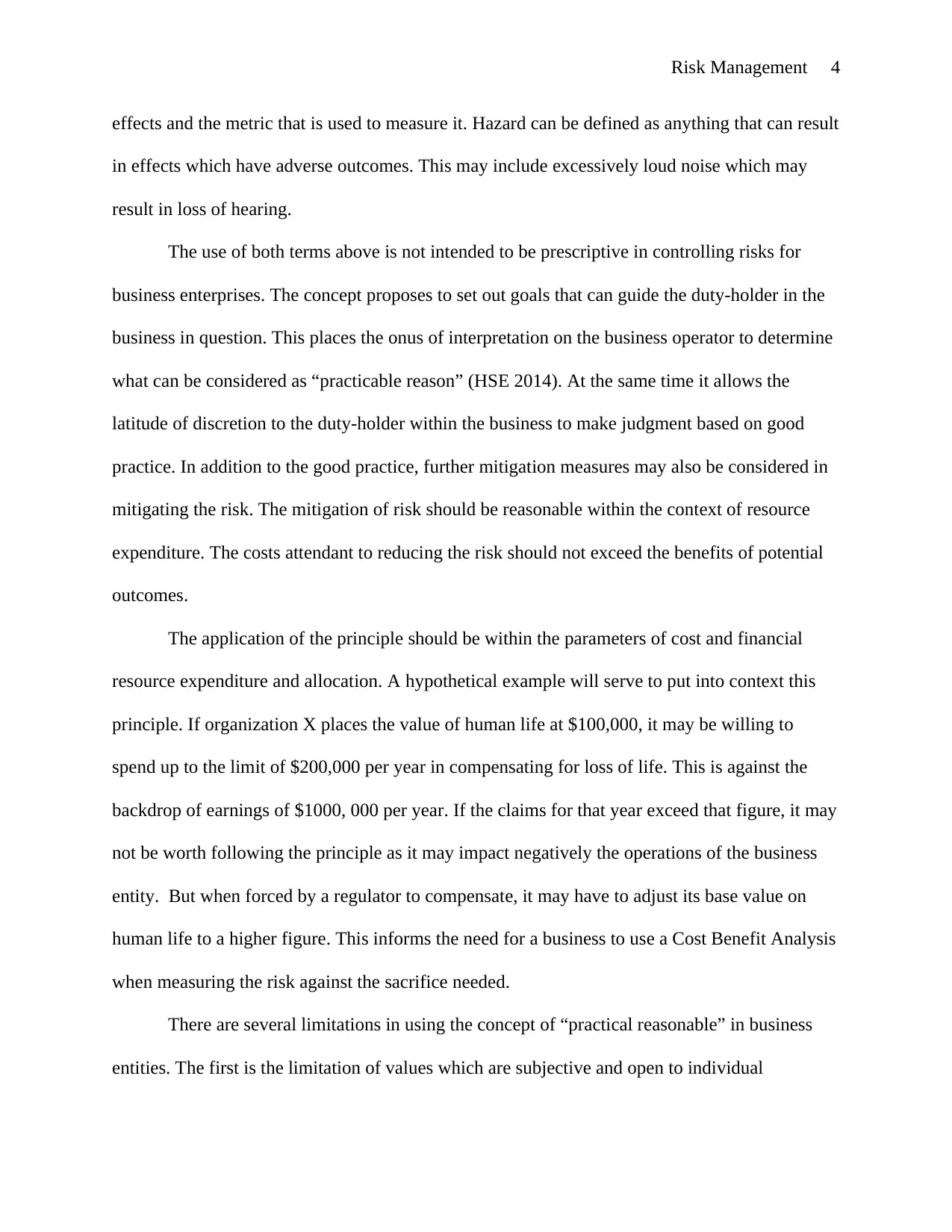
Risk Management 4
effects and the metric that is used to measure it. Hazard can be defined as anything that can result
in effects which have adverse outcomes. This may include excessively loud noise which may
result in loss of hearing.
The use of both terms above is not intended to be prescriptive in controlling risks for
business enterprises. The concept proposes to set out goals that can guide the duty-holder in the
business in question. This places the onus of interpretation on the business operator to determine
what can be considered as “practicable reason” (HSE 2014). At the same time it allows the
latitude of discretion to the duty-holder within the business to make judgment based on good
practice. In addition to the good practice, further mitigation measures may also be considered in
mitigating the risk. The mitigation of risk should be reasonable within the context of resource
expenditure. The costs attendant to reducing the risk should not exceed the benefits of potential
outcomes.
The application of the principle should be within the parameters of cost and financial
resource expenditure and allocation. A hypothetical example will serve to put into context this
principle. If organization X places the value of human life at $100,000, it may be willing to
spend up to the limit of $200,000 per year in compensating for loss of life. This is against the
backdrop of earnings of $1000, 000 per year. If the claims for that year exceed that figure, it may
not be worth following the principle as it may impact negatively the operations of the business
entity. But when forced by a regulator to compensate, it may have to adjust its base value on
human life to a higher figure. This informs the need for a business to use a Cost Benefit Analysis
when measuring the risk against the sacrifice needed.
There are several limitations in using the concept of “practical reasonable” in business
entities. The first is the limitation of values which are subjective and open to individual
effects and the metric that is used to measure it. Hazard can be defined as anything that can result
in effects which have adverse outcomes. This may include excessively loud noise which may
result in loss of hearing.
The use of both terms above is not intended to be prescriptive in controlling risks for
business enterprises. The concept proposes to set out goals that can guide the duty-holder in the
business in question. This places the onus of interpretation on the business operator to determine
what can be considered as “practicable reason” (HSE 2014). At the same time it allows the
latitude of discretion to the duty-holder within the business to make judgment based on good
practice. In addition to the good practice, further mitigation measures may also be considered in
mitigating the risk. The mitigation of risk should be reasonable within the context of resource
expenditure. The costs attendant to reducing the risk should not exceed the benefits of potential
outcomes.
The application of the principle should be within the parameters of cost and financial
resource expenditure and allocation. A hypothetical example will serve to put into context this
principle. If organization X places the value of human life at $100,000, it may be willing to
spend up to the limit of $200,000 per year in compensating for loss of life. This is against the
backdrop of earnings of $1000, 000 per year. If the claims for that year exceed that figure, it may
not be worth following the principle as it may impact negatively the operations of the business
entity. But when forced by a regulator to compensate, it may have to adjust its base value on
human life to a higher figure. This informs the need for a business to use a Cost Benefit Analysis
when measuring the risk against the sacrifice needed.
There are several limitations in using the concept of “practical reasonable” in business
entities. The first is the limitation of values which are subjective and open to individual
Paraphrase This Document
Need a fresh take? Get an instant paraphrase of this document with our AI Paraphraser
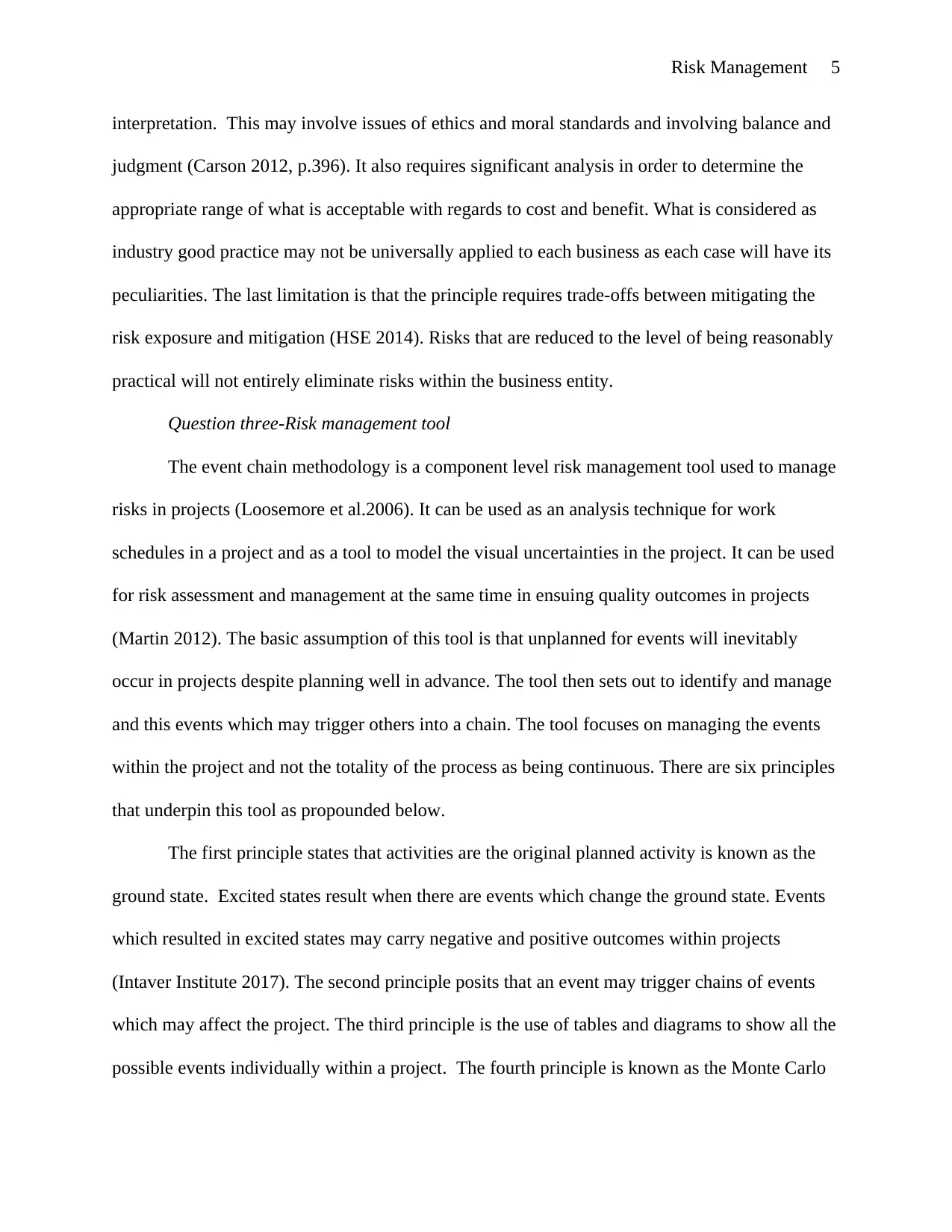
Risk Management 5
interpretation. This may involve issues of ethics and moral standards and involving balance and
judgment (Carson 2012, p.396). It also requires significant analysis in order to determine the
appropriate range of what is acceptable with regards to cost and benefit. What is considered as
industry good practice may not be universally applied to each business as each case will have its
peculiarities. The last limitation is that the principle requires trade-offs between mitigating the
risk exposure and mitigation (HSE 2014). Risks that are reduced to the level of being reasonably
practical will not entirely eliminate risks within the business entity.
Question three-Risk management tool
The event chain methodology is a component level risk management tool used to manage
risks in projects (Loosemore et al.2006). It can be used as an analysis technique for work
schedules in a project and as a tool to model the visual uncertainties in the project. It can be used
for risk assessment and management at the same time in ensuing quality outcomes in projects
(Martin 2012). The basic assumption of this tool is that unplanned for events will inevitably
occur in projects despite planning well in advance. The tool then sets out to identify and manage
and this events which may trigger others into a chain. The tool focuses on managing the events
within the project and not the totality of the process as being continuous. There are six principles
that underpin this tool as propounded below.
The first principle states that activities are the original planned activity is known as the
ground state. Excited states result when there are events which change the ground state. Events
which resulted in excited states may carry negative and positive outcomes within projects
(Intaver Institute 2017). The second principle posits that an event may trigger chains of events
which may affect the project. The third principle is the use of tables and diagrams to show all the
possible events individually within a project. The fourth principle is known as the Monte Carlo
interpretation. This may involve issues of ethics and moral standards and involving balance and
judgment (Carson 2012, p.396). It also requires significant analysis in order to determine the
appropriate range of what is acceptable with regards to cost and benefit. What is considered as
industry good practice may not be universally applied to each business as each case will have its
peculiarities. The last limitation is that the principle requires trade-offs between mitigating the
risk exposure and mitigation (HSE 2014). Risks that are reduced to the level of being reasonably
practical will not entirely eliminate risks within the business entity.
Question three-Risk management tool
The event chain methodology is a component level risk management tool used to manage
risks in projects (Loosemore et al.2006). It can be used as an analysis technique for work
schedules in a project and as a tool to model the visual uncertainties in the project. It can be used
for risk assessment and management at the same time in ensuing quality outcomes in projects
(Martin 2012). The basic assumption of this tool is that unplanned for events will inevitably
occur in projects despite planning well in advance. The tool then sets out to identify and manage
and this events which may trigger others into a chain. The tool focuses on managing the events
within the project and not the totality of the process as being continuous. There are six principles
that underpin this tool as propounded below.
The first principle states that activities are the original planned activity is known as the
ground state. Excited states result when there are events which change the ground state. Events
which resulted in excited states may carry negative and positive outcomes within projects
(Intaver Institute 2017). The second principle posits that an event may trigger chains of events
which may affect the project. The third principle is the use of tables and diagrams to show all the
possible events individually within a project. The fourth principle is known as the Monte Carlo
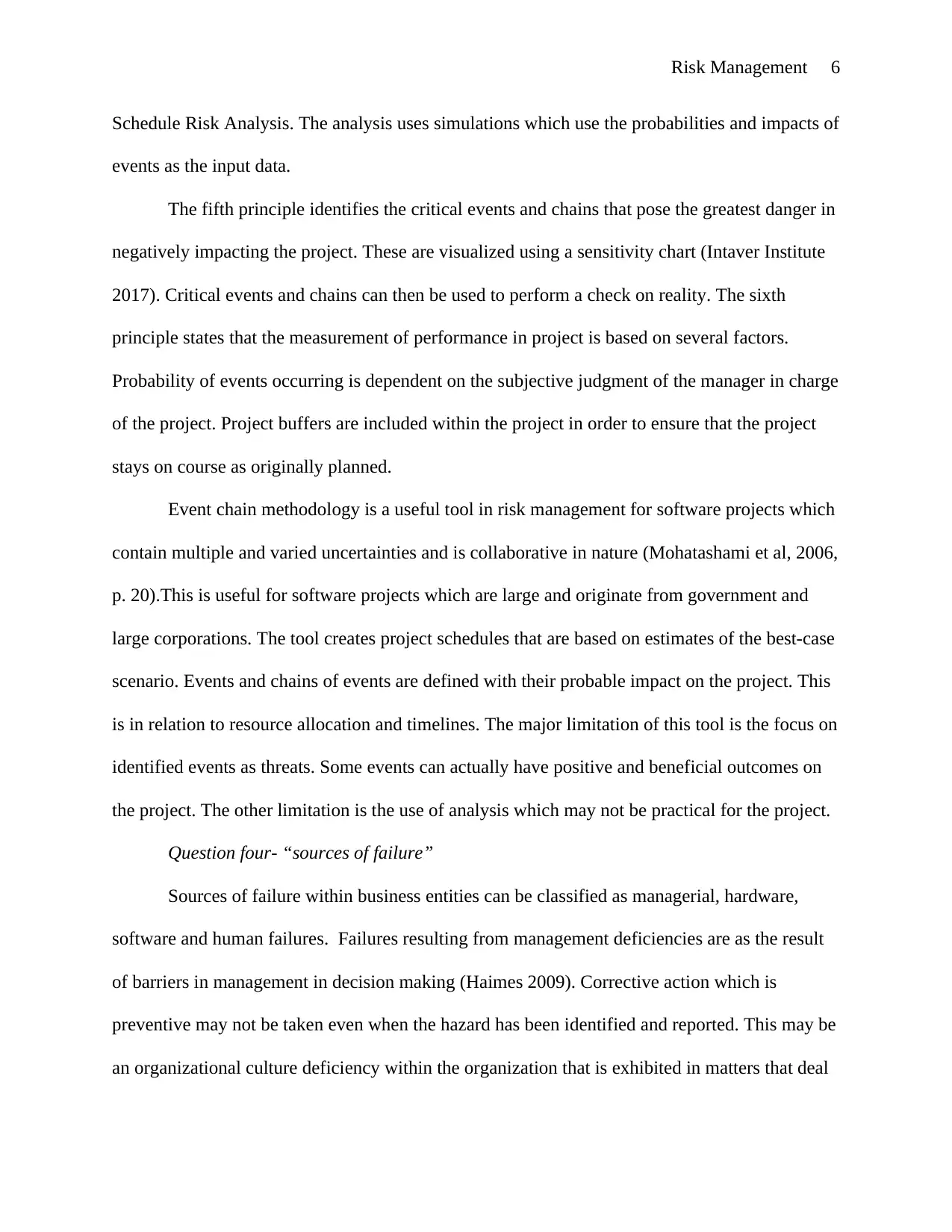
Risk Management 6
Schedule Risk Analysis. The analysis uses simulations which use the probabilities and impacts of
events as the input data.
The fifth principle identifies the critical events and chains that pose the greatest danger in
negatively impacting the project. These are visualized using a sensitivity chart (Intaver Institute
2017). Critical events and chains can then be used to perform a check on reality. The sixth
principle states that the measurement of performance in project is based on several factors.
Probability of events occurring is dependent on the subjective judgment of the manager in charge
of the project. Project buffers are included within the project in order to ensure that the project
stays on course as originally planned.
Event chain methodology is a useful tool in risk management for software projects which
contain multiple and varied uncertainties and is collaborative in nature (Mohatashami et al, 2006,
p. 20).This is useful for software projects which are large and originate from government and
large corporations. The tool creates project schedules that are based on estimates of the best-case
scenario. Events and chains of events are defined with their probable impact on the project. This
is in relation to resource allocation and timelines. The major limitation of this tool is the focus on
identified events as threats. Some events can actually have positive and beneficial outcomes on
the project. The other limitation is the use of analysis which may not be practical for the project.
Question four- “sources of failure”
Sources of failure within business entities can be classified as managerial, hardware,
software and human failures. Failures resulting from management deficiencies are as the result
of barriers in management in decision making (Haimes 2009). Corrective action which is
preventive may not be taken even when the hazard has been identified and reported. This may be
an organizational culture deficiency within the organization that is exhibited in matters that deal
Schedule Risk Analysis. The analysis uses simulations which use the probabilities and impacts of
events as the input data.
The fifth principle identifies the critical events and chains that pose the greatest danger in
negatively impacting the project. These are visualized using a sensitivity chart (Intaver Institute
2017). Critical events and chains can then be used to perform a check on reality. The sixth
principle states that the measurement of performance in project is based on several factors.
Probability of events occurring is dependent on the subjective judgment of the manager in charge
of the project. Project buffers are included within the project in order to ensure that the project
stays on course as originally planned.
Event chain methodology is a useful tool in risk management for software projects which
contain multiple and varied uncertainties and is collaborative in nature (Mohatashami et al, 2006,
p. 20).This is useful for software projects which are large and originate from government and
large corporations. The tool creates project schedules that are based on estimates of the best-case
scenario. Events and chains of events are defined with their probable impact on the project. This
is in relation to resource allocation and timelines. The major limitation of this tool is the focus on
identified events as threats. Some events can actually have positive and beneficial outcomes on
the project. The other limitation is the use of analysis which may not be practical for the project.
Question four- “sources of failure”
Sources of failure within business entities can be classified as managerial, hardware,
software and human failures. Failures resulting from management deficiencies are as the result
of barriers in management in decision making (Haimes 2009). Corrective action which is
preventive may not be taken even when the hazard has been identified and reported. This may be
an organizational culture deficiency within the organization that is exhibited in matters that deal
⊘ This is a preview!⊘
Do you want full access?
Subscribe today to unlock all pages.

Trusted by 1+ million students worldwide
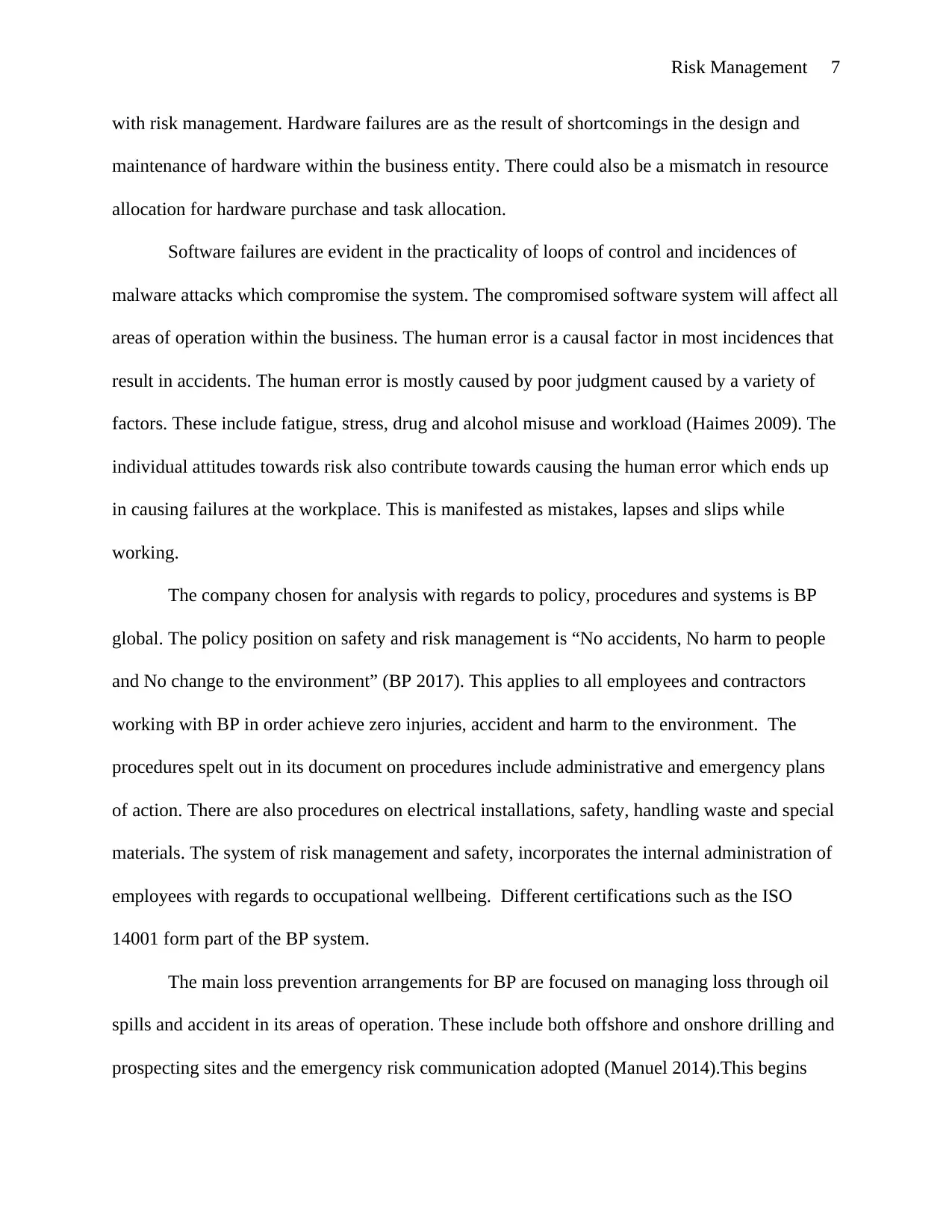
Risk Management 7
with risk management. Hardware failures are as the result of shortcomings in the design and
maintenance of hardware within the business entity. There could also be a mismatch in resource
allocation for hardware purchase and task allocation.
Software failures are evident in the practicality of loops of control and incidences of
malware attacks which compromise the system. The compromised software system will affect all
areas of operation within the business. The human error is a causal factor in most incidences that
result in accidents. The human error is mostly caused by poor judgment caused by a variety of
factors. These include fatigue, stress, drug and alcohol misuse and workload (Haimes 2009). The
individual attitudes towards risk also contribute towards causing the human error which ends up
in causing failures at the workplace. This is manifested as mistakes, lapses and slips while
working.
The company chosen for analysis with regards to policy, procedures and systems is BP
global. The policy position on safety and risk management is “No accidents, No harm to people
and No change to the environment” (BP 2017). This applies to all employees and contractors
working with BP in order achieve zero injuries, accident and harm to the environment. The
procedures spelt out in its document on procedures include administrative and emergency plans
of action. There are also procedures on electrical installations, safety, handling waste and special
materials. The system of risk management and safety, incorporates the internal administration of
employees with regards to occupational wellbeing. Different certifications such as the ISO
14001 form part of the BP system.
The main loss prevention arrangements for BP are focused on managing loss through oil
spills and accident in its areas of operation. These include both offshore and onshore drilling and
prospecting sites and the emergency risk communication adopted (Manuel 2014).This begins
with risk management. Hardware failures are as the result of shortcomings in the design and
maintenance of hardware within the business entity. There could also be a mismatch in resource
allocation for hardware purchase and task allocation.
Software failures are evident in the practicality of loops of control and incidences of
malware attacks which compromise the system. The compromised software system will affect all
areas of operation within the business. The human error is a causal factor in most incidences that
result in accidents. The human error is mostly caused by poor judgment caused by a variety of
factors. These include fatigue, stress, drug and alcohol misuse and workload (Haimes 2009). The
individual attitudes towards risk also contribute towards causing the human error which ends up
in causing failures at the workplace. This is manifested as mistakes, lapses and slips while
working.
The company chosen for analysis with regards to policy, procedures and systems is BP
global. The policy position on safety and risk management is “No accidents, No harm to people
and No change to the environment” (BP 2017). This applies to all employees and contractors
working with BP in order achieve zero injuries, accident and harm to the environment. The
procedures spelt out in its document on procedures include administrative and emergency plans
of action. There are also procedures on electrical installations, safety, handling waste and special
materials. The system of risk management and safety, incorporates the internal administration of
employees with regards to occupational wellbeing. Different certifications such as the ISO
14001 form part of the BP system.
The main loss prevention arrangements for BP are focused on managing loss through oil
spills and accident in its areas of operation. These include both offshore and onshore drilling and
prospecting sites and the emergency risk communication adopted (Manuel 2014).This begins
Paraphrase This Document
Need a fresh take? Get an instant paraphrase of this document with our AI Paraphraser
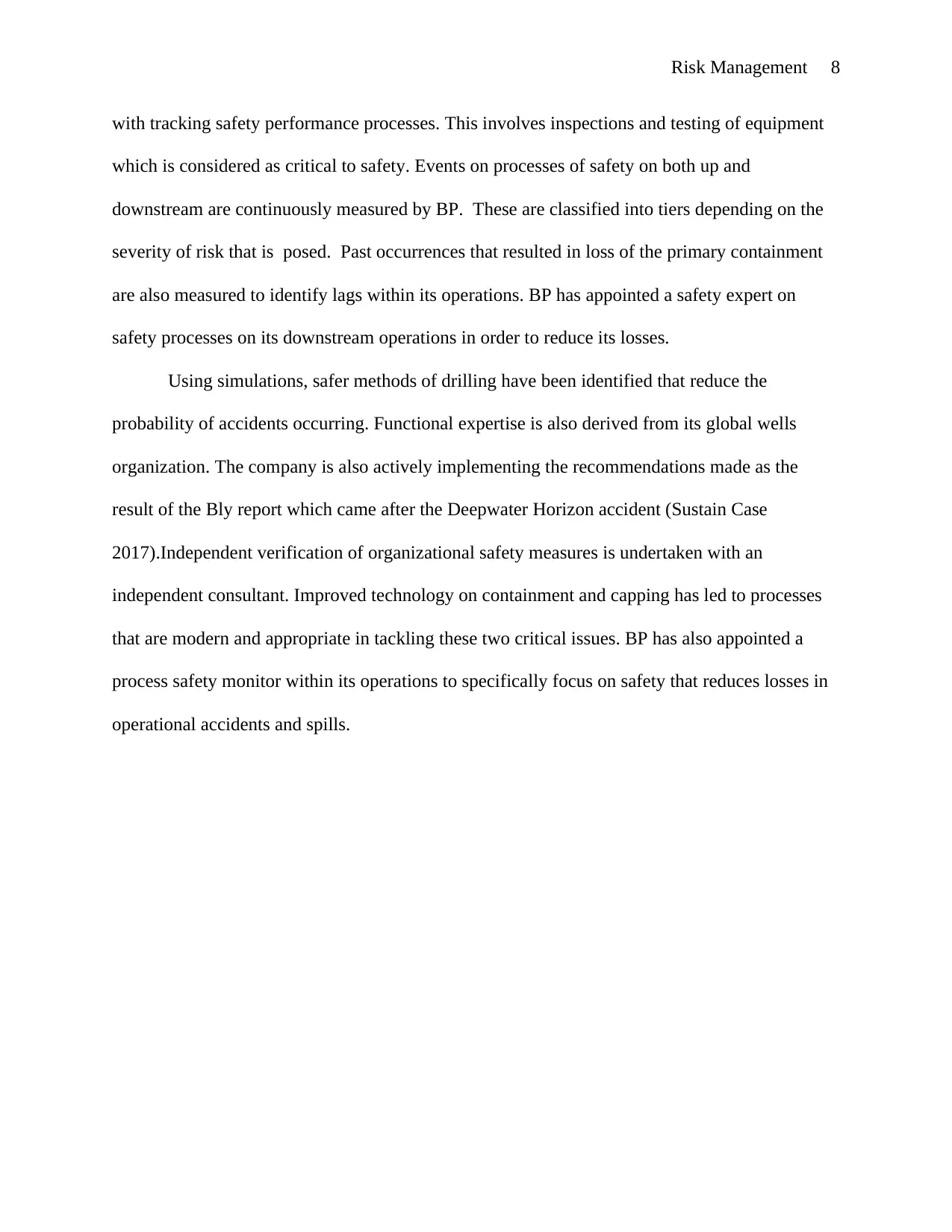
Risk Management 8
with tracking safety performance processes. This involves inspections and testing of equipment
which is considered as critical to safety. Events on processes of safety on both up and
downstream are continuously measured by BP. These are classified into tiers depending on the
severity of risk that is posed. Past occurrences that resulted in loss of the primary containment
are also measured to identify lags within its operations. BP has appointed a safety expert on
safety processes on its downstream operations in order to reduce its losses.
Using simulations, safer methods of drilling have been identified that reduce the
probability of accidents occurring. Functional expertise is also derived from its global wells
organization. The company is also actively implementing the recommendations made as the
result of the Bly report which came after the Deepwater Horizon accident (Sustain Case
2017).Independent verification of organizational safety measures is undertaken with an
independent consultant. Improved technology on containment and capping has led to processes
that are modern and appropriate in tackling these two critical issues. BP has also appointed a
process safety monitor within its operations to specifically focus on safety that reduces losses in
operational accidents and spills.
with tracking safety performance processes. This involves inspections and testing of equipment
which is considered as critical to safety. Events on processes of safety on both up and
downstream are continuously measured by BP. These are classified into tiers depending on the
severity of risk that is posed. Past occurrences that resulted in loss of the primary containment
are also measured to identify lags within its operations. BP has appointed a safety expert on
safety processes on its downstream operations in order to reduce its losses.
Using simulations, safer methods of drilling have been identified that reduce the
probability of accidents occurring. Functional expertise is also derived from its global wells
organization. The company is also actively implementing the recommendations made as the
result of the Bly report which came after the Deepwater Horizon accident (Sustain Case
2017).Independent verification of organizational safety measures is undertaken with an
independent consultant. Improved technology on containment and capping has led to processes
that are modern and appropriate in tackling these two critical issues. BP has also appointed a
process safety monitor within its operations to specifically focus on safety that reduces losses in
operational accidents and spills.
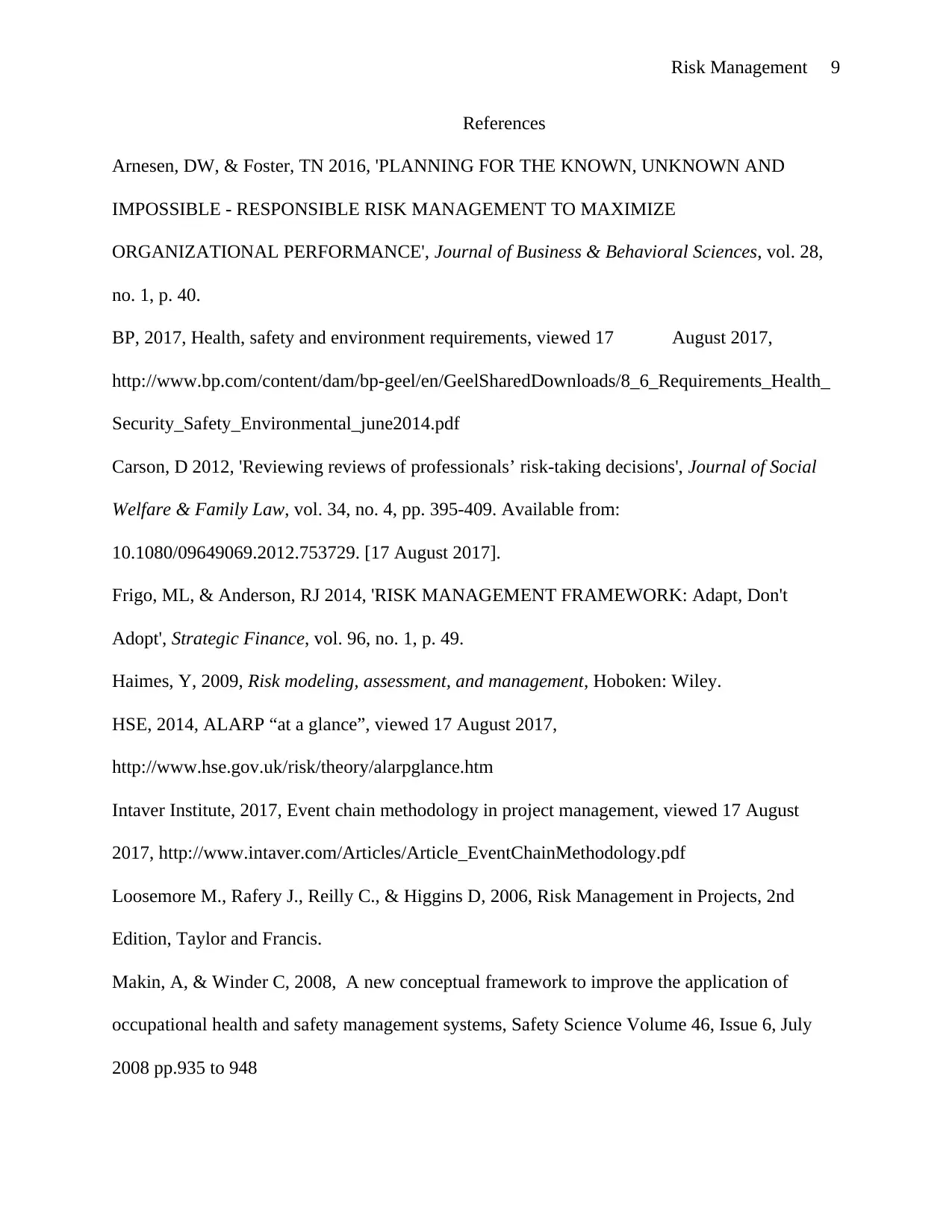
Risk Management 9
References
Arnesen, DW, & Foster, TN 2016, 'PLANNING FOR THE KNOWN, UNKNOWN AND
IMPOSSIBLE - RESPONSIBLE RISK MANAGEMENT TO MAXIMIZE
ORGANIZATIONAL PERFORMANCE', Journal of Business & Behavioral Sciences, vol. 28,
no. 1, p. 40.
BP, 2017, Health, safety and environment requirements, viewed 17 August 2017,
http://www.bp.com/content/dam/bp-geel/en/GeelSharedDownloads/8_6_Requirements_Health_
Security_Safety_Environmental_june2014.pdf
Carson, D 2012, 'Reviewing reviews of professionals’ risk-taking decisions', Journal of Social
Welfare & Family Law, vol. 34, no. 4, pp. 395-409. Available from:
10.1080/09649069.2012.753729. [17 August 2017].
Frigo, ML, & Anderson, RJ 2014, 'RISK MANAGEMENT FRAMEWORK: Adapt, Don't
Adopt', Strategic Finance, vol. 96, no. 1, p. 49.
Haimes, Y, 2009, Risk modeling, assessment, and management, Hoboken: Wiley.
HSE, 2014, ALARP “at a glance”, viewed 17 August 2017,
http://www.hse.gov.uk/risk/theory/alarpglance.htm
Intaver Institute, 2017, Event chain methodology in project management, viewed 17 August
2017, http://www.intaver.com/Articles/Article_EventChainMethodology.pdf
Loosemore M., Rafery J., Reilly C., & Higgins D, 2006, Risk Management in Projects, 2nd
Edition, Taylor and Francis.
Makin, A, & Winder C, 2008, A new conceptual framework to improve the application of
occupational health and safety management systems, Safety Science Volume 46, Issue 6, July
2008 pp.935 to 948
References
Arnesen, DW, & Foster, TN 2016, 'PLANNING FOR THE KNOWN, UNKNOWN AND
IMPOSSIBLE - RESPONSIBLE RISK MANAGEMENT TO MAXIMIZE
ORGANIZATIONAL PERFORMANCE', Journal of Business & Behavioral Sciences, vol. 28,
no. 1, p. 40.
BP, 2017, Health, safety and environment requirements, viewed 17 August 2017,
http://www.bp.com/content/dam/bp-geel/en/GeelSharedDownloads/8_6_Requirements_Health_
Security_Safety_Environmental_june2014.pdf
Carson, D 2012, 'Reviewing reviews of professionals’ risk-taking decisions', Journal of Social
Welfare & Family Law, vol. 34, no. 4, pp. 395-409. Available from:
10.1080/09649069.2012.753729. [17 August 2017].
Frigo, ML, & Anderson, RJ 2014, 'RISK MANAGEMENT FRAMEWORK: Adapt, Don't
Adopt', Strategic Finance, vol. 96, no. 1, p. 49.
Haimes, Y, 2009, Risk modeling, assessment, and management, Hoboken: Wiley.
HSE, 2014, ALARP “at a glance”, viewed 17 August 2017,
http://www.hse.gov.uk/risk/theory/alarpglance.htm
Intaver Institute, 2017, Event chain methodology in project management, viewed 17 August
2017, http://www.intaver.com/Articles/Article_EventChainMethodology.pdf
Loosemore M., Rafery J., Reilly C., & Higgins D, 2006, Risk Management in Projects, 2nd
Edition, Taylor and Francis.
Makin, A, & Winder C, 2008, A new conceptual framework to improve the application of
occupational health and safety management systems, Safety Science Volume 46, Issue 6, July
2008 pp.935 to 948
⊘ This is a preview!⊘
Do you want full access?
Subscribe today to unlock all pages.

Trusted by 1+ million students worldwide
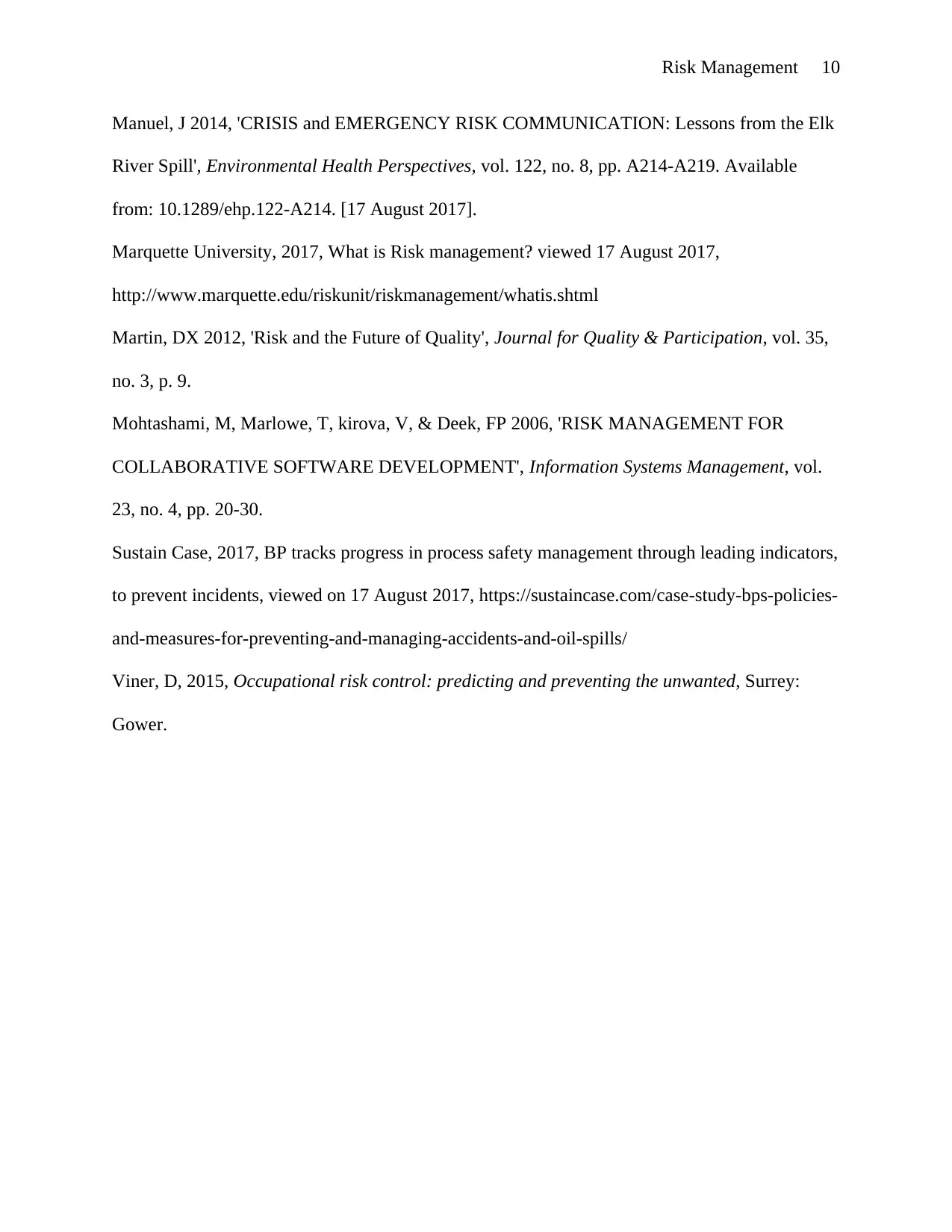
Risk Management 10
Manuel, J 2014, 'CRISIS and EMERGENCY RISK COMMUNICATION: Lessons from the Elk
River Spill', Environmental Health Perspectives, vol. 122, no. 8, pp. A214-A219. Available
from: 10.1289/ehp.122-A214. [17 August 2017].
Marquette University, 2017, What is Risk management? viewed 17 August 2017,
http://www.marquette.edu/riskunit/riskmanagement/whatis.shtml
Martin, DX 2012, 'Risk and the Future of Quality', Journal for Quality & Participation, vol. 35,
no. 3, p. 9.
Mohtashami, M, Marlowe, T, kirova, V, & Deek, FP 2006, 'RISK MANAGEMENT FOR
COLLABORATIVE SOFTWARE DEVELOPMENT', Information Systems Management, vol.
23, no. 4, pp. 20-30.
Sustain Case, 2017, BP tracks progress in process safety management through leading indicators,
to prevent incidents, viewed on 17 August 2017, https://sustaincase.com/case-study-bps-policies-
and-measures-for-preventing-and-managing-accidents-and-oil-spills/
Viner, D, 2015, Occupational risk control: predicting and preventing the unwanted, Surrey:
Gower.
Manuel, J 2014, 'CRISIS and EMERGENCY RISK COMMUNICATION: Lessons from the Elk
River Spill', Environmental Health Perspectives, vol. 122, no. 8, pp. A214-A219. Available
from: 10.1289/ehp.122-A214. [17 August 2017].
Marquette University, 2017, What is Risk management? viewed 17 August 2017,
http://www.marquette.edu/riskunit/riskmanagement/whatis.shtml
Martin, DX 2012, 'Risk and the Future of Quality', Journal for Quality & Participation, vol. 35,
no. 3, p. 9.
Mohtashami, M, Marlowe, T, kirova, V, & Deek, FP 2006, 'RISK MANAGEMENT FOR
COLLABORATIVE SOFTWARE DEVELOPMENT', Information Systems Management, vol.
23, no. 4, pp. 20-30.
Sustain Case, 2017, BP tracks progress in process safety management through leading indicators,
to prevent incidents, viewed on 17 August 2017, https://sustaincase.com/case-study-bps-policies-
and-measures-for-preventing-and-managing-accidents-and-oil-spills/
Viner, D, 2015, Occupational risk control: predicting and preventing the unwanted, Surrey:
Gower.
1 out of 10
Related Documents
Your All-in-One AI-Powered Toolkit for Academic Success.
+13062052269
info@desklib.com
Available 24*7 on WhatsApp / Email
![[object Object]](/_next/static/media/star-bottom.7253800d.svg)
Unlock your academic potential
Copyright © 2020–2025 A2Z Services. All Rights Reserved. Developed and managed by ZUCOL.



